
© Railway Wonders of the World 2012-


The South Eastern & Chatham Railway
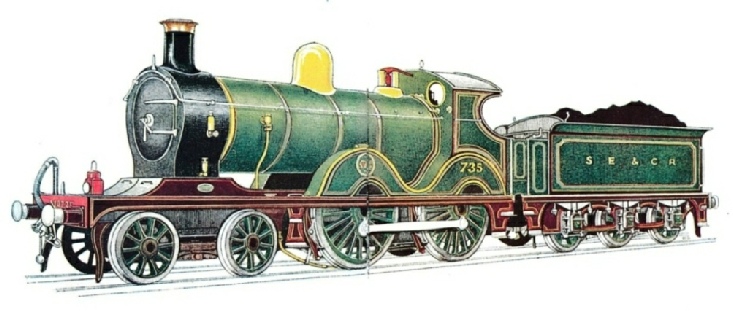
SOUTH EASTERN & CHATHAM RAILWAY EXPRESS PASSENGER LOCOMOTIVE, No. 735
DESIGNED BY Mr HARRY WAINWRIGHT, M.INST,C.E.
THE South Eastern & Chatham claims the county of Kent for its own, and extends for a short distance into Sussex and all through Surrey into Berkshire. Beginning as the Dover Railway to afford a route between London and the Continent, it is the chief road that way still, and of its 654 miles of track the 76 to Dover are those to which it gives its best attention. From Dover go the Calais and Ostend boats; and it has two other mail-
All down the south side of the Thames from London Bridge to Port Victoria every town and village is served by the South Eastern & Chatham; and so it is all the way round from Sheerness to Hastings. Quite a number of seaside places besides those mentioned are in its territory -
If the age of a railway be that of its oldest branch, the South Eastern is older than the North Western -
In the early days of the last century Canterbury wanted a port, the old cathedral city seeming to be doomed to no other means of communication with the rest of the world than coach and wagon, and prices were rising alarmingly. Its old port of Fordwich had become silted up, though not so much so as to-
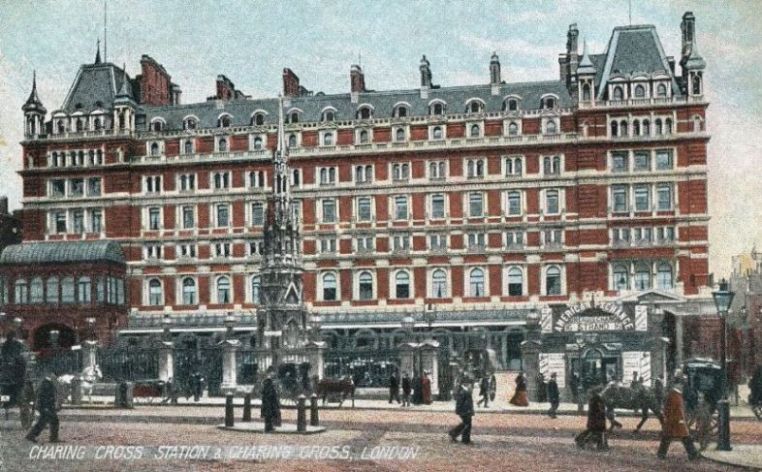
CHARING CROSS, WITH STATION AND HOTEL
Thus it came about that in 1822 the citizens resolved on improving the river Stour and making it navigable from Sandwich, as it used to be; and, after much talk and a little surveying, they introduced a Bill into Parliament in the 1824 session which was opposed by the Commissioners of Sewers on the ground of inadequate surveys and evident under-
The way seemed clear for the Stour improvement; but while the discussion was in progress in 1823, there happened to be in Canterbury no less a person than William James, the promoter of “engine railroads” as he called them, the friend and partner for a time of George Stephenson, whose department so far as the partnership was concerned was “to give his best assistance for the using and employing the locomotive engines” on railways south of an imaginary line drawn from Hull to Liverpool.
James, according to Robert Stephenson, was the original projector of the Liverpool & Manchester. There may be some doubt about this; there is none about his promotion of the Canterbury & Whitstable. He did his best for the partnership. He wrote and spoke and agitated generally to such effect that he got together a rail party in the city to oppose the river party, which obtained so much support that in 1824 he was sufficiently advanced to apply to George Stephenson for him to send down a surveyor; and Stephenson sent him John Dixon of Chat Moss fame.
Dixon was a practical engineer who knew what he was about, and had very soon been over the half-
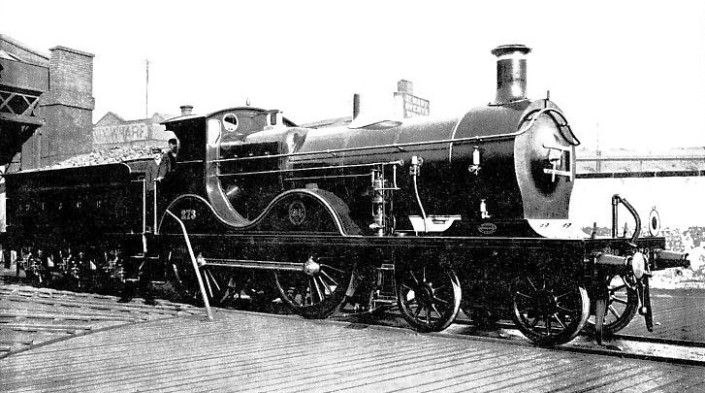
No. 273 GOING ONTO THE TURNTABLE AT CANNON STREET
The thing is almost incredible, but it is the fact. The Canterbury people insisted on having a tunnel; Dixon’s plans were rejected, and Stephenson was asked to journey to Canterbury in person and plan out a route with a nice tunnel in it. Needless to say there was no difficulty; the site for a tunnel was found at Tyler Hill, and to reach it and get through to Whitstable the road lay through a strip of country undulating enough and picturesque enough to please any one who did not mind paying for it, and it contained everything no complete railroad should be without.
It started from North Lane at a gradient of 1 in 41, and went at 1 in 56 for over 3000 yards to Tyler Hill, necessitating a pair of 25 horse-
The line was made by navvies sent down from the north -
There was never a dividend. The line was always worked at a loss, but it never stopped working until it was relaid on being leased by the South Eastern in 1844. Some time after it opened it was leased to contractors who worked it with horses and tried to sell its only engine; but, there being no other rails for it to run on nearer than Greenwich, there were no buyers, and it was left to be taken over with the rest of the plant by the South Eastern people, who took up the old 15 ft. Birkinshaw rails, 28 lb. to the yard, with their oak sleepers a yard apart, and the sheaves a fathom apart on which the ropes ran. The old signals were also taken away -
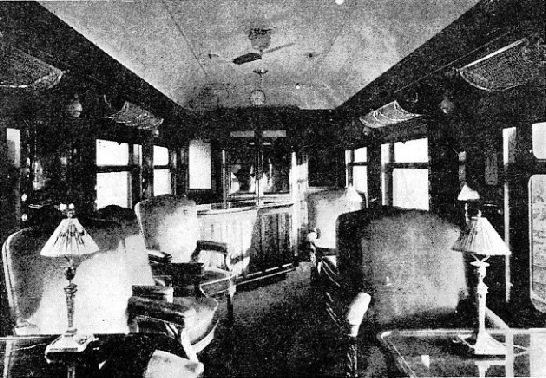
THE BUFFET CAR OF THE CONTINENTAL EXPRESS
The Invicta was at Ashford for years; now she is in the Dane John gardens at Canterbury, but not in her original state. As built by the Stephensons -
The £50 shares of the old company were at ten shillings before the news got about that the South Eastern were going to take over the line, and then they went up to £30, but the South Eastern did not buy the line until 1853; from 1844 until then they only leased it. The famous tunnel there was so much fuss about was rather small at the Whitstable end, and it was not enlarged, so the antiquity of the present carriages must be excused. They are only little ones.
The next link of the South Eastern chain was the Greenwich line, the first of London’s railways. It was the first overhead railway, and its engineer was George Thomas Landmann, once a colonel of Royal Engineers, who after many adventures had taken to railway work. It ran from Joiner Street, Southwark, 1144 yards from the Royal Exchange, to Greenwich, 3¾ miles, the turnpike road being 5½ miles; and it was on brick arches all the way, 878 of them, except for an iron bridge over Bermondsey Street and a lifting bridge over Ravensbourne Creek. The arches were adopted because much of the route lay below Thames high-
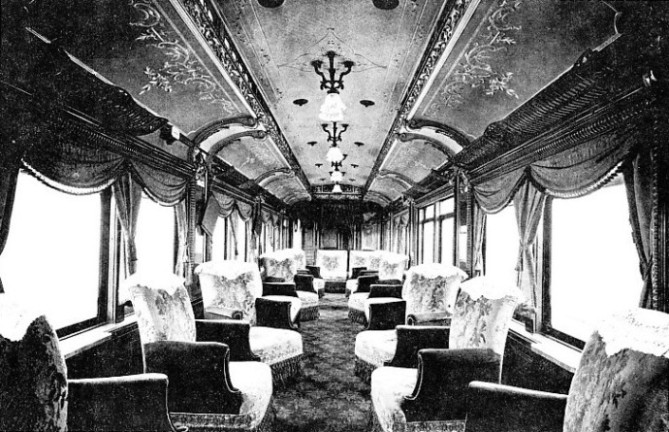
DRAWING-
The contractor was Hugh M’Intosh, and his undertaking was not so profitable as he anticipated owing to his having in places to go down 24 ft. to get a firm foundation for the arches; but he did his work well, as can be seen in the monotonous viaduct which is still as level as when he made it. The rails, a double line of them, were fastened into the chairs by malleable iron wedges, the chairs being fixed to rough blocks of granite, or Bramley Fall stone, of about four cubic feet each, but between the chair and the stone Landmann put a thin piece of elm plank, thus beginning the return to the old wooden sleeper.
The site of the terminus is included within the present London Bridge Station. It was approached by a sloping carriage road and a paved footpath, and entered through handsome iron gates. As originally laid out, it was 60 ft. wide by 400 ft. long, with four lines of rails converging to two at 130 yards from the entrance, but the first building seems to have been a shed. The line was opened to Deptford on the 14th of December 1836, and in the first year there were 1,462,591 passengers who paid -
We must now go back a little. In 1825 a railway was being talked about from Manchester to Liverpool, why should there not be one from London to Dover? And what better route could there be than from London along the Thames valley to Gravesend and then on; or even from Gravesend to Dover, thus avoiding the voyage round the Forelands? So a line was projected -
Next year, while the numerous companies anxious to go to Brighton were in full endeavour, a third scheme was introduced -
This was the Central Kent, one of the lines projected by Sir John Rennie. The Central Kent was to run from London Bridge to Sandwich by way of Lewisham, Eltham, the Crays, the Darent, Gravesend, crossing the Medway a mile above Rochester, thence within a mile of Maidstone to Eastwell, where it sent off a branch to Ashford, Folkestone, and Dover, while the main line went on through Canterbury to Sandwich. Up the valley of the Darent there was to be a branch to Sevenoaks and Tonbridge, and thus nearly every important town in Kent was provided for; and the route to Dover was fourteen miles shorter than that for which the Act had been obtained, and its steepest gradient was 1 in 264. This would undoubtedly have been the best line, and the South Eastern people would have substituted it for theirs had it not been for the opposition of Lord Winchelsea and the people of Maidstone, who would not hear of any railway coming near their town, which they considered to be amply provided for by the barges on the Medway. And so the project fell through.
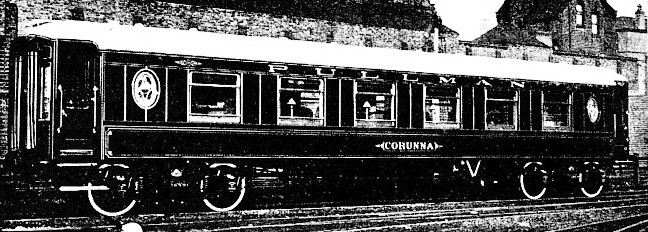
THE NEW PULLMAN CAR “CORUNNA”
Thus it came about that under the Act of 1837 the Brighton Company made the line from Redstone Hill (Redhill) to Jolly Sailor (Norwood Junction) on the London & Croydon, the South Eastern paying £340,000, half the cost with interest of the twelve-
The engineer of the South Eastern was Sir William Cubitt, who invented the treadmill and did many other things besides making canals, harbours, and railways. In his evidence before the Gauge Commission he said, “With a perfect railway I do not know any speed that could be dangerous to the public safety in a straight line”; and he laid out the South Eastern for speed with a perfectly straight run of forty-
These tunnels through the chalk were made by driving in horizontal galleries from the sea-
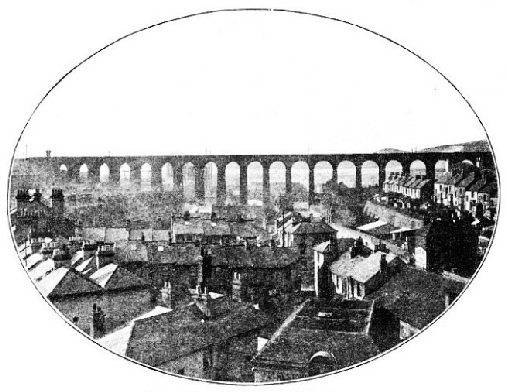
THE FOORD VIADUCT AT FOLKESTONE
“At the time appointed for the blasting, a number of distinguished visitors reached the Downs, and joined the directors and the scientific corps at a commodious pavilion erected near the edge of the cliff, at a distance of about a quarter of a mile from the point of explosion. When the arrangements were completed and the spectators assembled, curiosity was at its height, and the most strange and fearful speculations were entertained by the people assembled as to the possible contingencies which might arise. ‘What’, said Professor Sedgwick -
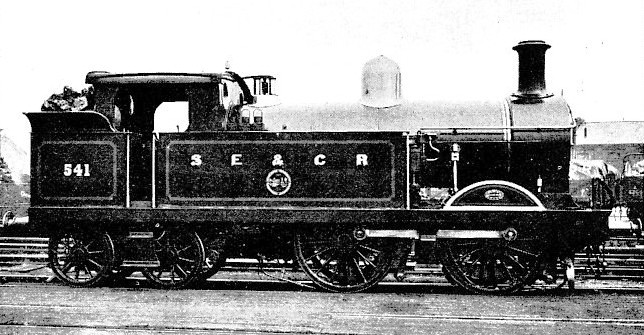
No. 541 -
The best-
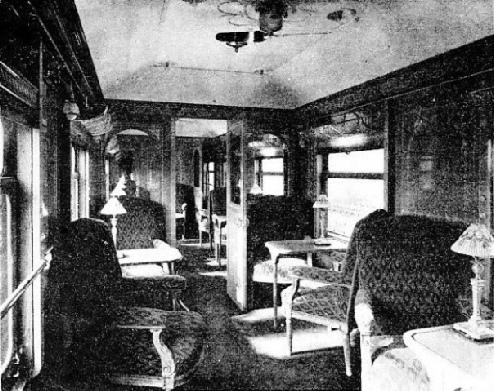
NEW DRAWING-
The Bletchingley tunnel was opened in May 1841. In May next year the first train ran through from London to Tonbridge, then called Tunbridge, where the branch to Tunbridge Wells, opened two years afterwards, had been begun. In August Headcorn was reached, and in December the trains began to run through to Ashford. In 1843 the line was opened to Folkestone, and the year following it reached Dover.
That year, 1844, was an important one for the company, for not only did they get to Dover, but they opened their first London branch, that to their new “West End Station” -
Bricklayers Arms is notable in railway story for the step forward there taken in signalling. When it was opened, Charles Gregory, who introduced the semaphore into railway practice by placing the first at New Cross, gathered the chains from all the signals into a stirrup frame, and fixed to the frame a sort of parallel motion that ran between the stirrups in such a way that the depression of any one stirrup pushed the parallel bars into a position to act as a block on the others. Thus two conflicting signals could not be given at the same time. This was not quite interlocking, as there was no mechanical connection between the signals and the points, but it was the first move in that direction.
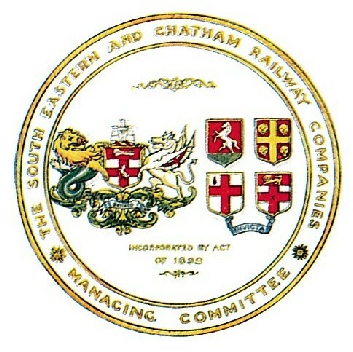
SOUTH EASTERN & CHATHAM RAILWAY COAT OF ARMS
In 1856, when the signalling arrangements were enlarged and improved, John Saxby of Saxby & Farmer worked from the signal cabin eight semaphores and six pairs of points, all so governed and locked that it was impossible to move any signal which was contrary to the position of the points, and equally impossible to give any signal that was in conflict with another. The principle was the simultaneous movement of points and signals contrived in such a way that the signals were dominated by the points.
Saxby was the first to put in a row together the levers for working the points as well as those for working the signals. At first he used rocking shafts, but in 1860 he replaced these by sliding bars, the principal levers being vertical and the locking levers horizontal. In 1867 he introduced locking by the spring catch, so that before the lever was moved the mere intention of moving it effected the locking, and a wrong signal could not be given by negligence or any strain or slackness of the apparatus; but in this device he ran a sort of dead heat with Easterbrook, who was three days in front of him with one patent and three days behind him with the next, so that for a short time no levers could be moved owing to Saxby having secured one end of them while Easterbrook had hold of the other.
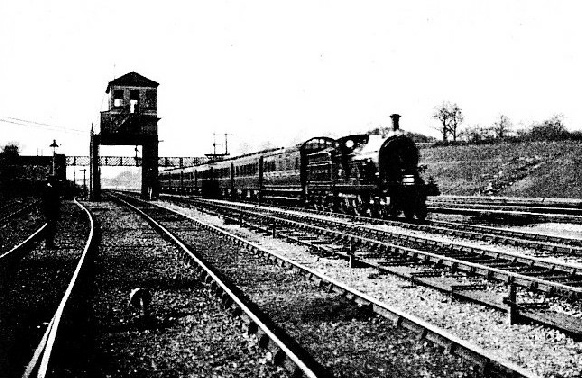
THE AMERICAN CAR TRAIN AT FULL SPEED NEAR ORPINGTON
There was another patent for interlocking of which some mention must be made. In October 1859 Kentish Town Station was ready for opening on the North London when Colonel Yolland, the Government Inspector, refused to pass it as he wanted some means of preventing the signalman from making a mistake. Stevens, the contractor for the signalling work, undertook to put this right, and the opening was postponed for him to do so. In November Colonel Yolland came again to examine the new contrivance, in which the signals were so arranged that the putting down of one stirrup disengaged the other. The colonel put his foot into both stirrups, and so lowered both the up main and the up branch; and he, refused to pass the line. He was asked to suggest some way out of the difficulty. “Oh”, said he, “it is not my province to suggest but to approve”. But having understood what the colonel had in his mind, Austin Chambers tackled the problem, and in a month was ready for the colonel with an arrangement that was satisfactory, and the line was opened in December. The same day the General Manager gave Chambers a cheque for fifty pounds to patent the invention, and this was done; and it was immediately, adopted all over the North Western.
Neither of these interlocking systems can be understood without an examination, of the mechanism or working a model. They have been compared to a church organ, but as has been well said of them, a performer on the organ can touch any keys he pleases in any order or in any number; he can discourse most eloquent music, or he can rend the ears of his audience by abominable discord. Not so the signalman. Concord he can produce at will, but discord is utterly beyond his powers. He cannot open the points to one line and at the same time give a safety signal to a line which crosses it; and the points must be properly set or the signal for a train to pass cannot possibly be given. Moreover, while a train is actually travelling through the points, not even the signalman can change their position or disturb them until the last vehicle has passed in safety. When he gives a clear signal for a main line, he cannot open a point crossing to it; and when he gives a clear signal for a crossing he must show danger for all the lines which it crosses. He can send a train on to any one line, but he has to do so in a systematic manner, and if he brings about an accident it is not by one pull of a lever but by the pull of perhaps half a dozen, all in due order and strictly according to rule; and often in these days he is stopped from doing this by the man in another box, with which his signals are also connected.

The simplification of signalling is progressing apace and soon it will be almost entirely automatic, and it is interesting to note that the Chatham & Dover did much to help along the reform by its early introduction of Sykes’s electric block system alluded to above. The telegraph block, however, goes back much earlier, for it was introduced on the Yarmouth & Norwich in the very year that Bricklayers Arms was opened with Gregory’s stirrups; while signalling by electrical contacts began in a small way on the Lancaster & Preston in 1849.
The block system on which our trains are now worked is not difficult to understand. The line is divided into sections by signal-
Meanwhile confusion was increasing with increase of business at “the Bridge” with four companies running into it. As a remedy they ceased to work independently after the 1st of March 1844, when a joint committee was formed. Next year matters were simplified by the South Eastern taking over the London & Greenwich on a 999 years’ lease at a rental of £45,000. In the following January the committee was dissolved, and in July the London & Brighton absorbed the London & Croydon and became the London, Brighton, & South Coast. This left two companies in the place of four, both using the same metals from Redhill and both running in on to the arches at Corbett’s Lane for the last 3036 yards into London Bridge; and though the South Eastern soon began to find other outlets from the Greenwich line, that arrangement lasted until the Brighton opened their new line from Purley to Earlswood fifty-
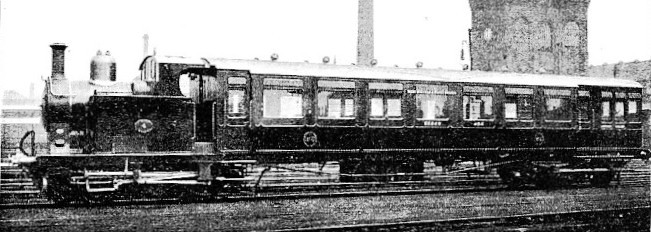
A SMART LITTLE STEAM CAR ON THE WICKHAM & HAYES BRANCH
The same year, 1846, the South Eastern continued its line north-
In 1843, Morris, who had left Rennie to become one of the contractors for making the South Eastern, bought Telford’s old harbour at Folkestone for £10,000, to sell it again to the company for a considerable consideration, and thither the branch from Folkestone was opened in 1849 so as to give the company another route to France. In time the railway company bought the boats that were working the passage; but they would not buy the Dover boats when they were offered to them, and thereby came trouble.
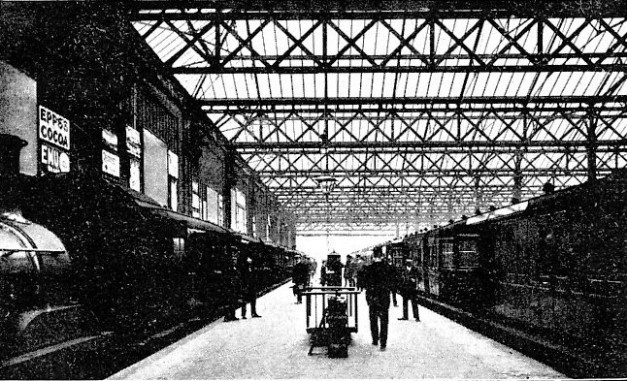
CHARING CROSS STATION, SHOWING NEW ROOF
The railways are said by some people to have been welcomed owing to the exorbitant charges and high profits of the canal companies. There were, however, some canals that made no profits, and of such was the Thames & Medway projected in 1804. This went from Gravesend to Strood, and was a little over seven miles long, thus giving the barges a much shorter route to Chatham than round by Sea Reach, if they would only have used it, which they did not. When practically insolvent it was taken over by a railway company who, converting only the part from Higham, opened a line from Gravesend to Strood in 1847. Here was a line in the wilderness that was not long to remain so, for two years afterwards came the North Kent from the Greenwich, through New Cross and Black-
In 1849 the line through Surrey was opened to Reading. No one acquainted with the ways of our railways will be surprised at the South Eastern going west or even northwest; but this particular branch is due to amalgamation. The route is of strategic importance, and, among the many schemes promoted in 1845, Parliament dealt with those for filling the gap between Redhill and Reading in such a way that the Reading, Guildford, & Reigate, and the Staines, Wokingham, & Woking, were authorised to construct and use the line which is now this part of the South Eastern, there being certain interchanges of running powers between the South Eastern and South Western. In 1851 and 1852 Ashford and Tonbridge were looped up by the lines to Hastings, the next move being the business extension from Charlton to Angerstein’s Wharf, the company’s river port.
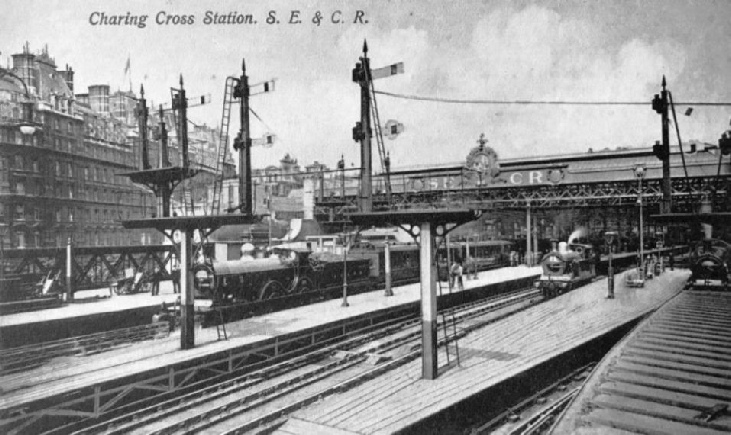
THE CONTINENTAL EXPRESS PREPARING TO START FROM CHARING CROSS
The Chatham & Dover was now beginning to take shape, and for some seven years the South Eastern lay quiet preparing for the great effort by which its rival was not to be crushed. This was its coming over the Thames to its big stations in the Strand and Cannon Street. It meant two bridges across the river and the purchase of property at extortionate prices; and its cost was about £1000 a yard for a little over 2½ miles. At Cannon Street an entirely new bridge had to be built; at Charing Cross the Hungerford suspension bridge had to be bought with the obligation of retaining the footway, and though the old piers came in useful for some of the columns of the new bridge, foundations for the others were not so easily found.
The station was built by an independent company and taken over by the South Eastern in 1864; it is not as it was, for owing to the failure of a tie-
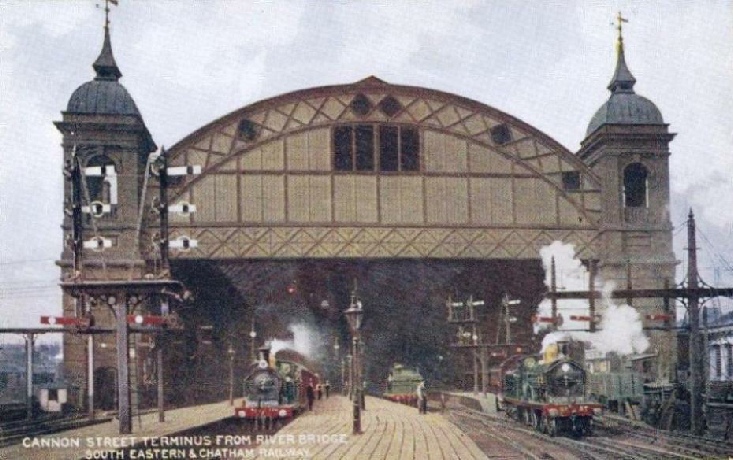
CANNON STREET STATION -
At the eastern end of the main platform at Waterloo there is a single line leading out, which is occasionally used for passing troop trains through. It belongs to the South Eastern, and was put there to give through communication between north and south when the Charing Cross line was opened and there was no Waterloo Junction but a station at Blackfriars Road. In July 1865 a service of trains was put on from Euston through Kensington and Vauxhall that went over this line to London Bridge, and next year these trains ran into Cannon Street, further complicating the working and being little patronised. The South Western complained that the South Eastern Company were deliberately discouraging the service, as they were, and at last gave that company notice to complete their engagements and build Waterloo Junction. This, much against their will, they were compelled to do, for they had hoped to save the expense; but as some relief they asked that the through service should be taken off, and this was done on New Year’s Day 1867. Meanwhile the competition of the Chatham & Dover had forced the South Eastern to find a shorter main road, and in 1868 there was opened the new route to Tonbridge through Sevenoaks, an extension of the line from St. John’s to Chislehurst completed four years before.
The story of the London, Chatham, & Dover can be more briefly summarised. It began with a building estate at Herne Bay belonging to George Burge who, under Telford, was the contractor for the St. Katharine’s Docks and the pier at Herne Bay along which the cars were driven by sails. Burge had bought the property in the hope that some day a railway would come along to increase its value, and when the Central Kent was being surveyed he made the acquaintance of John Rennie’s two assistants: Morris, who did so well afterwards in purchasing Folkestone Harbour, and Thomas Russell Crampton, a railway engineer of importance.
Crampton, a Broadstairs man born in 1816, was a fellow-
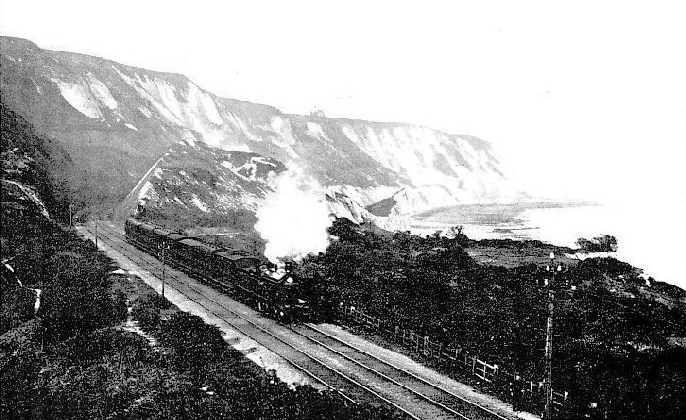
LONDON EXPRESS PASSING THE WARREN, BETWEEN DOVER AND FOLKESTONE
So many of Crampton’s engines came to be used on the South Eastern and Chatham & Dover, that, though she belonged to another line, some particulars may be given here of this much-
The Compagnie du Nord of France, agreeing in the advantages of her low centre of gravity, accessible working parts, and liberal bearing surfaces, ordered several like her. In fact they worked their line with Cramptons from 1849 to 1876, and of one of their engines there is a working model at South Kensington which is most popular amongst the boys who like to see the wheels go round. Crampton did something else besides designing locomotives; he it was who in 1851, taking over the enterprise in the time of difficulty, laid the first practicable submarine cable between Dover and Calais.
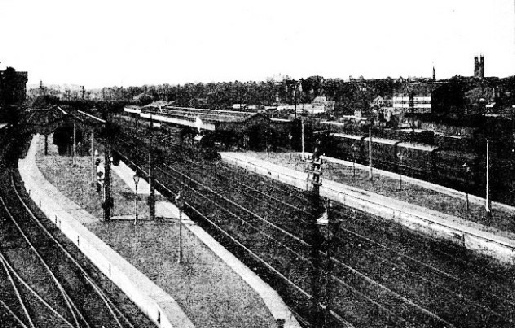
ASHFORD JUNCTION
Burge wanted a line from London that would reach Herne Bay; Morris and Crampton thought there was an opening for a shorter road to Dover, and soon the three went into partnership and began seeking about for capital and support in the usual way to make one of the links in the projected route, that to Canterbury through Faversham from the North Kent at Rochester Bridge, with a branch from Faversham to Herne Bay to be made by the Kent Coast Company. “Morris, Crampton, and Burge”, says Sir John Rennie, “commenced the London, Chatham, & Dover Railway with comparatively very little support for an undertaking of the kind, and experienced very great uphill work; so much so, that Burge got alarmed, and Morris and Crampton bought him out. Morris and Crampton still struggled on with it, and then Morris went out, and Crampton remained alone. At last he got Peto and Betts to join him, and then the concern went ahead. Lord Sondes, a large landed proprietor in Norfolk and in Kent, also joined them, and they completed the original line”. And he might have added did something more, for with it in 1860 there was finished the line from Sittingbourne to Sheerness, which afterwards went to Queenborough, while the Kent Coast had got as far as Whitstable; and in addition to these the Bromley to Bickley line, which had been opened in 1858, was carried on to Rochester Bridge. In 1861 the London, Chatham, & Dover, as it had become, reached Dover, and was ready to work with the boats that had been bought when the South Eastern refused them; and in another two years the Kent Coast was extended to Ramsgate, to become the property of the Chatham in 1871.
Meanwhile it had been growing at the other end. The year it reached Dover it was at Penge; the year it reached Ramsgate it was at Herne Hill, where it joined up with the section already made to the Elephant. And thus it grew by small instalments until it arrived at Victoria and Ludgate Hill, and then the Viaduct and St. Paul’s, and could run on its own metals all the way. How it was all done was a mystery on which some light was thrown when, in 1861, nearly every one connected with it went into bankruptcy, and Lord Salisbury and Lord Cairns began their three years’ work as arbitrators, which ended in the Arbitration Act of 1869 with its drastic revision of the capital account.
A road made by joining up short lengths in this way was not likely to be an easy one, and the Chatham & Dover track is the worst for speed running out of London. For fifty of the miles between London and Dover the gradients range from 1 in 100 to 1 in 132, and only eighteen of the miles are easier than 1 in 200. For twenty-
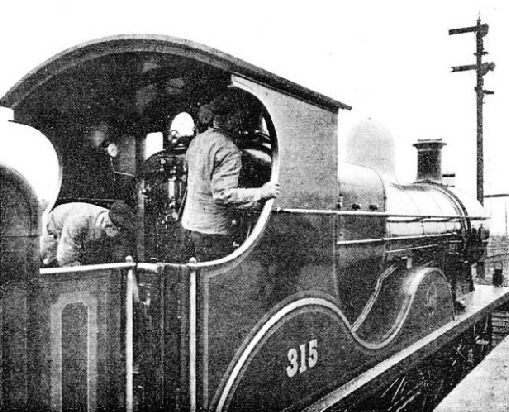
THE DRIVER’S CAB OF NO. 315
The old South Eastern by way of Redhill was easy enough, from Forest Hill onwards, as far as gradients and curves were concerned, but the present main line is quite another sort of road. As soon as it passes St. John’s it begins to go up at 1 in 140, 1 in 120, 1 in 146, 1 in 310, 1 in 120, and 1 in 170 to Halstead; then down at 1 in 143, 1 in 204, and 1 in 150; and up from Dunton Green at 1 in 160 into Sevenoaks tunnel, 3451 yards in length, and down at 1 in 144 and 1 in 122 to Tonbridge, where it joins the old Cubitt line and runs nearly level to Headcorn, whence it rises from 100 ft. to 280 ft. at Saltwood tunnel, and by a falling gradient averaging 1 in 260 for the twelve miles reaches Dover.
The long pull up out of London, to say nothing of the hindrances north of Hither Green, is responsible for a great deal of the South Eastern’s reputation for slowness, but considering the weight of the trains it is by no means bad going, and could not be so well done if it were not for the really good engines that work its best trains. The engines are good enough, the permanent way is of the best, the rails, 91 lb. to the yard, are heavy enough; and yet, for the reasons mentioned, no company gives you so much of its time for the money.
Ashford Station, that site of many changes, has been quite transformed from what it used to be. As rebuilt it is one of the largest and most convenient junction stations that any company possesses, and there are rumours of much improvement in the services of the lines beyond. It has had a long history, for it was opened in 1842, five years before the locomotive works were ready to begin business. Prior to that they were at New Cross, in the shed now used by the Brighton Company for its London Bridge engines.
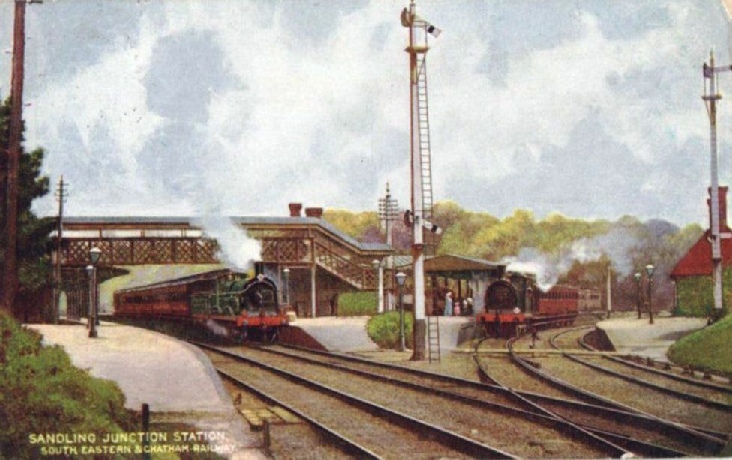
SANDLING JUNCTION -
The first engines for the line were supplied by Sharp, Roberts, & Co., and soon went into the general stock of the old Joint Committee. When the Committee was dissolved the engines were shared among the companies, the South Eastern taking most of those originally belonging to it and a few more that had belonged to the London & Croydon. Then came batches of twos, threes, fours, and sixes from builders like Nasmyth, Bury, Tulk & Ley, Jones & Potts, and Forester up till 1851, when ten new Cramptons from the Stephensons were put on the line to wake it up a bit. One of these, No. 136, the Folkestone, was in the 1851 Exhibition along with the company’s “London and Europe Carriage”, an eight-
In 1853, James Janson Cudworth built the first engine at Ashford -
It was in October and November of that year that he made his experiments with No. 142. This was fitted with a long, sloping firebox 7 ft. 6-
During 1857 Cudworth put on the line the first of his large class of goods engines, two of which, built in 1863, had Mansell wooden wheels. In 1861 came the first of his 7 ft. singles, 2-
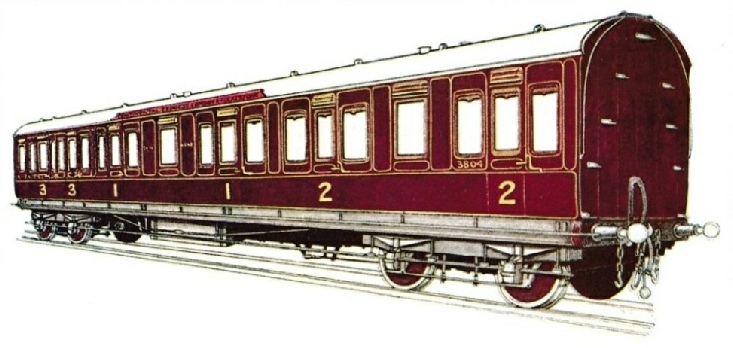
SOUTH EASTERN & CHATHAM RAILWAY COMPOSITE CARRIAGE, NO. 3804
He made havoc of what was irreverently known as the museum, and left the line with a new stock of engines, nearly all of which were designed by himself. The requirements of the traffic when he took over were on a far larger scale than they had been, and his engines had to be of much more power and weight. One of his engines, No. 240, was prominent at the Paris Exhibition of 1889 -
Mr. Stirling was succeeded by Mr. H. S. Wainwright, whose fine engine No. 516 was conspicuous as the only British locomotive at the Franco-
The Chatham & Dover locomotive works were at Longhedge in Battersea, now used as a branch for repairs, all the new work being done at Ashford. The later engines by Mr. Kirtley, particularly those for the Continental trains and the tanks for Metropolitan work, were much better than they got credit for, except amongst engineers, but they came during the intermediate period when there was little of general interest in the experimental way, and further building was put an end to by the amalgamation in 1899. The carriage works are also at Ashford, and the newer coaches are excellent specimens of workmanship, there having been a great improvement in the general rolling stock. American cars -
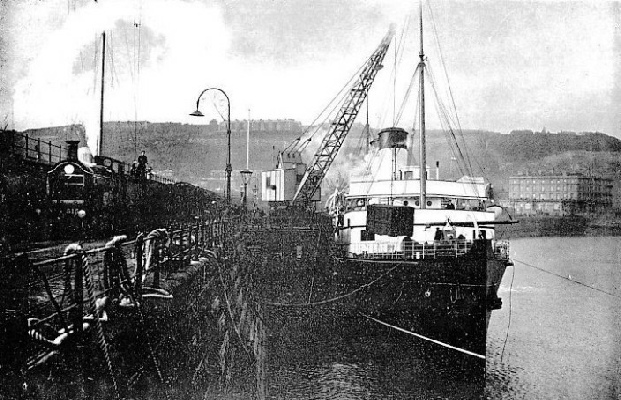
ARRIVAL OF THE BOAT TRAIN AT DOVER. R.M.S. EMPRESS PREPARING TO LEAVE FOR CALAIS
Of course the South Eastern must be in the fashion and have its motor trains, and on some of its branches nothing more is required. It has a good many branches and crossroads with a future before them after a sleepy past, many of them made in the old competition days for competitive purposes only -
Ashford is not the only station which has been greatly improved. Victoria has been taken in hand with remarkable success and become quite a handsome, roomy terminus. The new building bears on its front the name of the Great Western as well as that of the South Eastern, to mark its joint ownership dating from the days when its rails were both broad and narrow gauge. In fact the London termini, Victoria, Charing Cross, Holborn Viaduct, St. Paul’s, and Cannon Street, are all good; and Ludgate Hill, which was once a terminus as Blackfriars used to be, has been rebuilt as an intermediate station to great advantage, though, to spoil the view of the cathedral from Fleet Street, the signals remain on the redecorated bridge which gives bold display to the company’s arms, the special bearings of the old South Eastern with the “Onward” that used to be so inappropriate, and the four shields, Kent, London, Dover, and Rochester (with the old English r on the cross) that distinguishes the London, Chatham, & Dover.
There is no company better provided with London stations. Of the 667 miles of railway in Greater London it owns 124, and of the 609 stations within that area it owns 98, 6 of them being north of the Thames. Its own metals run in from Herne Hill to Snow Hill Junction in the direction of Moorgate Street -
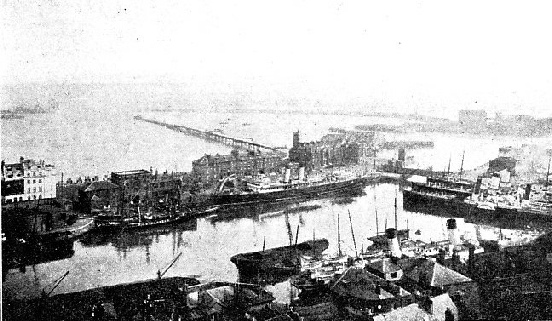
That it has a large local traffic is shown by its season tickets, from which it obtains a greater revenue than any other line except the Great Eastern. But the Great Eastern amount includes over £71,000 for workmen’s tickets, which on the South Eastern reach only £38,000. As the Great Eastern total is £410,489, and the South Eastern’s £392,118, the difference, £33,000, would put the South Eastern at the head of the season-
The South Eastern carries the Continental and Indian and Australian mails. From Queenborough go the Dutch boats to Flushing; from Folkestone goes the quickest route to Paris; from Dover go the Belgian boats to Ostend and the British and French boats to Calais with the mails on their way to Marseilles, Naples, and Brindisi, and practically everywhere in Europe and Asia; and the mail starting with its hundreds of sacks, or being shipped at Dover, is a sight to see. Queenborough is a pier and nothing more, Folkestone is an ordinary harbour, but Dover in the present day is a wonder. The Admiralty pier, begun in 1847, has been extended from 1550 ft. to 3550 ft. to form the south-
To say nothing about naval matters and ocean liners, there is no doubt about the increase in the trade, and the railway people very naturally do their best to foster it. At the new Marine Station close to the “Lord Warden”, erected by arrangement between the Dover Harbour Board and the railway company, the cross-
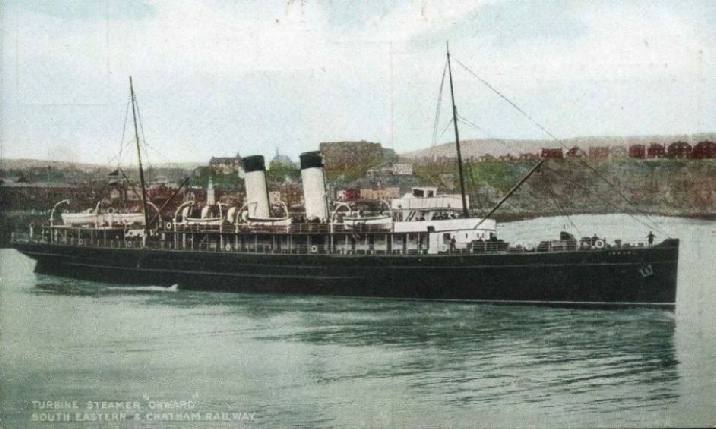
THE ONWARD LEAVING FOLKESTONE HARBOUR FOR BOULOGNE
You can read more on “The Dover Pullman Boat Express”, “The Kent Coast Express” and “The Story of the Southern” on this website.